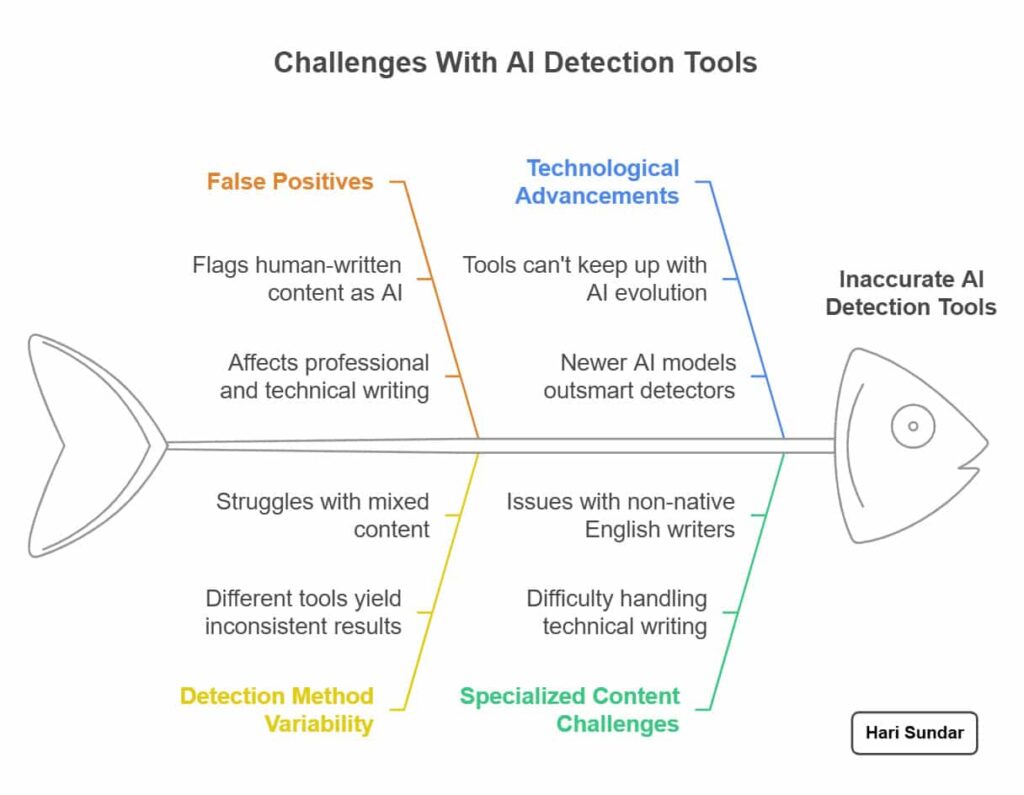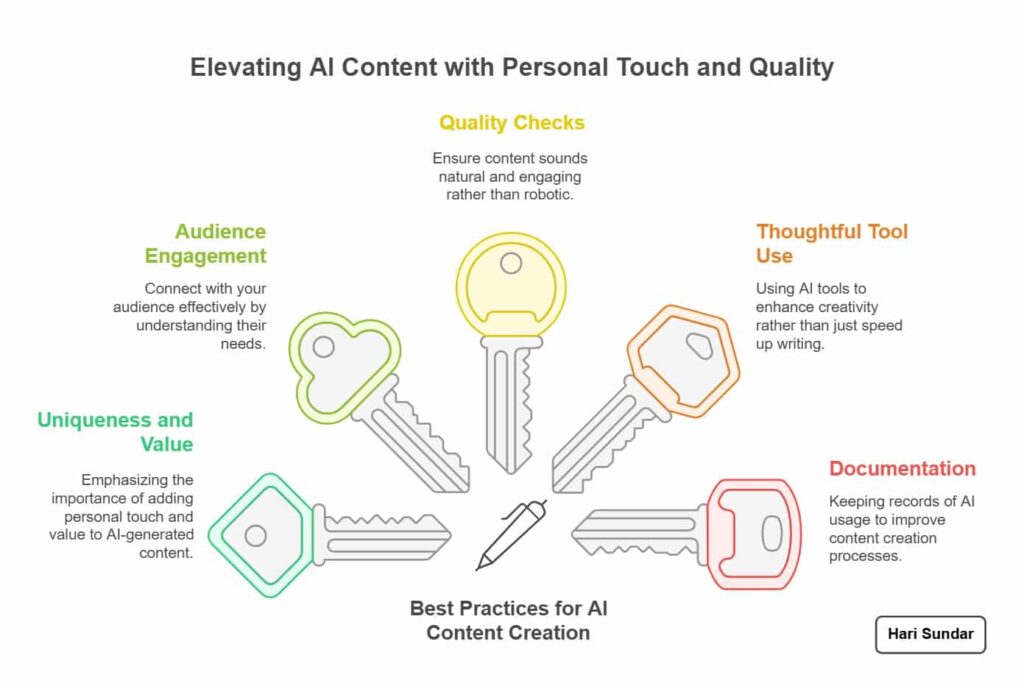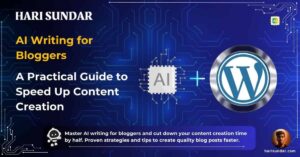What Is AI Content Detection: Why It Matters In 2025 (Guide)

You know that feeling when you write something brilliant, but someone says “Did AI write this?”
It’s like being accused of using a calculator in math class – technically helpful, but everyone acts like it’s cheating! As someone who writes with AI for blogging, I get this reaction all the time.
Did you know that, around 69% of marketers are using ChatGPT for content creation, but many aren’t sure if their content will pass AI detection tools?
I’ve spent countless hours testing different AI detection tools on my blog posts. Sometimes they flag my most personal, human-written pieces as “AI-generated,” while sometimes, or might be completely missing actual AI content.
So, whether you’re a blogger working with clients or a business owner creating content, you need to know what is AI content detection and how it works.
No fancy tech talk, just practical information on what AI content detection means for content creators in this AI age.
Here’s what you are going to learn today:
🔍 Understand what is AI content detection and how it works
⚠️ Know why even the best AI detectors make mistakes
📊 Know what AI detection tools look for in your content and their accuracies
💻 Stay informed about how AI detection affects your writing
✍️ Take action: Practical steps to improve your content today
Are you ready to understand these digital detectives better? Let’s start with the basics of what AI detection is and how AI detectors work.
What is AI Content Detection?

AI content detector is a software that checks if text was written by AI like ChatGPT or by a human. As more people learn how to use AI in blogging and marketing, these detection tools have become really important.
They work by looking for patterns that AI writing tends to follow. Think of it like a teacher checking if a student copied their homework.
The teacher looks for certain signs – maybe the writing sounds too perfect or uses words the student normally wouldn’t know. AI detectors do something similar but with computer code instead of a teacher’s trained eye.
A recent study found that 37.4% of marketers now use AI detection tools to check content. This shows how common these tools have become, especially for:
- Schools checking student essays
- Companies reviewing job applications
- Publishers screening submitted articles
- Websites monitoring user content
- Marketing teams reviewing freelance work
But there’s a catch – these tools aren’t perfect. Sometimes they mark human writing as AI-generated or miss actual AI content.
This happens because AI writing has gotten good at sounding natural, making it harder to spot.
Here’s what these tools look for:
- Repeated phrases and patterns
- How words flow together
- Sentence structure variety
- Word choice and vocabulary
- Writing style consistency
You’ll find AI detectors being used in many places today. News websites use them to check submitted stories.
Teachers run student papers through them. Even some email systems now scan for AI-generated spam.
The tools work differently depending on what you need. Some are free and simple – you paste in text and get a yes/no answer about whether it’s AI-written.
Others cost money but give detailed reports about why they think something is or isn’t AI-generated.
One thing many people get wrong is thinking these tools are perfect at spotting AI writing. The truth is, they too make mistakes.
Just like how spell-checkers can sometimes mess up and mark the right words as wrong, AI detectors can mistakenly tag human writing as AI-generated or totally miss AI content.
So, if you’re creating content, it’s a good idea not to rely too heavily on what these detection tools tell you.
The best approach is using them as one tool among many for checking content quality, not as the final word on whether something is AI-written or not.
But how exactly do these detection tools figure out what’s AI-written and what’s human-written? That’s what we’ll explore next – the actual technology behind AI content detection.
How Does AI Content Detection Work?

AI content detectors function similarly to fingerprint scanners for text.
Just as every individual possesses distinct fingerprints, AI-generated content typically exhibits specific patterns that these tools are designed to identify.
When you write a blog post with AI, the tool analyzes the text to find these telltale signs.
Let me break this down with a simple example. Think of how you can tell a text from your friend versus one from a stranger.
Your friend might use certain words, write in a specific way, or structure their messages differently. AI detectors do something similar – they look for patterns that are common in AI writing.
Here’s what these tools check in your text:
- Word patterns and how often certain words appear together
- How sentences connect and flow
- The mix of short and long sentences
- How varied the vocabulary is
- Whether the writing style stays consistent
The detection process happens in three main steps:
- The tool breaks down your text into smaller pieces
- It checks these pieces against known patterns of AI writing
- It calculates how likely it is that AI wrote the text
As Ryan Robinson, a successful blogger, points out:
“Most bloggers haven’t figured out quite what to make of AI yet. Those getting the strongest results have figured out how to weave these tools into their creation process while keeping themselves—what makes their content truly special—front and center.”
These tools use something called “training data” to learn what AI writing looks like.
Think of it like teaching a dog to recognize cats – you show it lots of pictures of cats until it learns what a cat looks like. Similarly, these detectors learn by analyzing thousands of AI-written and human-written texts.
Some common markers these tools flag include:
- Too-perfect grammar and punctuation
- The overly consistent writing style
- Repeated phrase structures
- Predictable word combinations
- Unusual patterns in how ideas connect
One interesting thing is how these tools measure “naturalness” in writing.
They know that humans tend to write with more ups and downs – sometimes formal, sometimes casual, sometimes making small mistakes. AI often writes more consistently, which can make it easier to spot.
But here’s the catch – AI writing keeps getting better and harder to detect. The tools that worked perfectly a few months ago might struggle with new AI content today.
So how accurate are these detection tools really, and can we trust their results? Continue reading because that’s what we’ll cover next.
Accuracy and Limitations of AI Detection Tools

Let’s talk about something surprising: AI detection tools aren’t as accurate as many people think.
Even OpenAI’s own classifier only spots AI-written text correctly 26% of the time. It’s like trying to catch a chameleon that keeps changing its colors.
Many website owners ask if Google can detect AI content reliably. The truth is, that even big tech companies struggle with this. Think of it like trying to tell if a painting is real or fake – sometimes even experts get it wrong.
The biggest problems these tools face are false positives. This means they often say human-written content is AI-generated when it’s not. Here’s what I’ve found after testing various AI detection tools:
- They often flag professional writers’ work as AI-written
- Technical writing frequently gets marked as AI content
- Non-native English writers’ content often triggers false alarms
- Well-edited AI content sometimes passes as human-written
These tools face real challenges that make them unreliable. For example, when I ran the same text through different detectors, I got completely different results.
One tool would say “100% human,” while another would claim “90% AI.” It’s like asking five different people to guess your age – you’ll probably get five different answers.
The main issues with current detection tools include:
- They can’t keep up with new AI writing technology
- Each tool uses different detection methods
- They struggle with mixed content (part AI, part human)
- Many can’t handle specialized or technical writing
What makes this even trickier is that AI writing keeps getting better. Today’s detection tools might work okay on content from older AI models, but they often fail with newer ones.
It’s like trying to catch a fish with a net that has holes too big – the smarter fish just swim right through.
Some content creators have found their perfectly human-written articles branded as AI-generated by these tools.
This has caused real problems, especially for freelance writers who must prove their original work. It’s frustrating when a tool incorrectly flags your hard work as machine-generated.
So what should content creators do if these tools have so many problems?
Do they need to find some better ways to handle AI content in publishing and marketing? That’s what we are going to explore in our next section about the impact on content creation.
Impact on Content Creation and Publishing
AI detection is changing how we create and share content online. Writers now think twice about how they use AI tools, and many are learning how to edit AI content properly to make it more natural and valuable for readers.
The changes are happening fast. Recent data shows that 54% of content creators now use AI for generating ideas, while only 6% use it for complete drafts.
Now schools and universities have started using detection tools to check student work. As a result, students are pushed to focus on original thinking instead of just copying AI outputs.
For businesses, AI detection has created new challenges. Companies need to:
- Train their writers on proper AI tool use
- Set clear policies about AI content
- Check content before publishing
- Keep records of content creation methods
- Balance speed with quality
The publishing world has changed too. Many websites now require writers to confirm their content is original.
Writers should be more careful about how they create their content, some websites even ask for proof that content can pass AI detection checks.
Content teams are changing their strategies because of AI detection. Instead of relying on AI to write everything, they’re using it more like a helpful assistant. They might use AI for research and outlines, but add their expertise and style to the final piece.
The interesting change I looked at over these years is how writers work and adapt to AI. I saw many of them are getting better at guiding the AI in the right direction, but some still struggle to get better outputs from the AI tools.
It’s like a chef using both hand tools and machines in the kitchen, writers are finding the right mix of AI assistance and human creativity.
Some of the content writers worried AI detection would make their jobs harder. But it’s actually pushed many to become better at their craft. Now they are focusing on adding value to their content that AI simply can’t do.
So what’s the best way to work with AI while keeping your content authentic and valuable? Let’s look at some tested strategies in our next section about best practices for content creators.
Best Practices for Content Creators

As creators publish more and more content with AI, the content that feels natural has become more important than ever.
To improve your AI content, you need to add uniqueness and value for your readers. Let me share what works based on real testing with different AI detection tools.
The first rule is simple: Don’t publish AI content straight from the tool.
As John Doherty from EditorNinja points out,
“AI is, by default, bad at writing content meant for a specific audience. By turning the AI into an audience member, you will not only write copy that converts better, but you can also decrease the amount of editing needed before the content is ready for publication.”
Here’s what I’ve found works best when creating content:
- Mix AI-generated ideas with your own experiences
- Add real examples that only you would know
- Change sentence patterns to sound more natural
- Include your unique insights and opinions
- Break up perfect-looking paragraphs
Quality checks are crucial before publishing. I always test my content by reading it out loud. If it sounds robotic or too perfect, it probably needs more editing.
When picking tools to help with content creation, look for ones that help you think better, not just write faster.
Use AI tools like you’d use a calculator – great for helping with the basics, but you still need to know what you’re doing.
One trick that works well is writing your main points first, then using AI to help fill in the details. So that, you can keep your original ideas at the center while using AI to fill in the gaps.
I made the mistake of not documenting my AI writing. So, always keep a record of how you use AI to create content. Note down which parts you wrote and which parts AI helped with.
Keep in mind that, your content should actually help an audience, not just on passing detection tools. Add your personality, share your real experiences, and make your content stand out naturally.
The tools will keep changing, and be flexible to new trends, but always good writing that connects with readers will matter. Now, let’s put the things together we’ve learned so far.
Conclusion
So, AI content detection is definitely sticking around, but it doesn’t have to be a big deal. The trick is to find a good mix between using AI tools and keeping your own vibe in your writing.
From what I’ve seen, getting around AI detection isn’t about pulling a fast one on the system; it’s really about making your content more genuine and relatable.
Think of these AI detection tools as little nudges to infuse more of your personality into what you write.
They encourage us to create real, reader-focused content that connects in ways AI just can’t.
Here are some easy steps you can take right now:
– Take a look at your current content strategy and see where you can sprinkle in some personal flair.
– Choose one piece of content and try blending AI assistance with your own ideas.
– Keep a record of your content creation process to see what works best for you.
– Test your content with different detection tools to get a feel for how they operate.
– Share your own stories and examples in your writing.
Just remember, the goal isn’t to outsmart AI detectors but to create content that truly resonates!
FAQs on AI Content Detection
Can AI content detectors really tell if a human or AI wrote something?
They can make educated guesses, but they’re not perfect. Like a detective looking for clues, these tools search for patterns in writing that might suggest AI created it. They often make mistakes, sometimes marking human writing as AI-generated and missing actual AI content.
How does AI content detection actually work?
These tools analyze writing patterns, checking things like sentence structure, word choices, and how ideas flow together. It’s similar to how you might spot a friend’s writing style – AI detectors look for telltale signs that suggest computer-generated text.
What are the best AI detection tools available?
While I use ChatGPT for blogging, I also regularly test content with tools like Brandwell (previously Content at Scale), Originality.ai, and GPTZero. Each has its strengths, but remember none are 100% accurate.
How can I avoid AI content detection?
Focus on adding your personal experiences, using real examples, and varying your writing style. Don’t try to trick detectors – instead, create genuinely good content that mixes AI assistance with human creativity.
Why do detection tools sometimes give different results?
Each tool uses its own method to spot AI content. It’s like having different teachers grade the same paper – they might notice different things and give different scores.
Does Google penalize AI-written content?
Google cares about content quality, not whether AI helped create it. They focus on whether the content is helpful, accurate, and valuable to readers.
How accurate are AI content detectors?
Most tools claim 80-90% accuracy, but real-world testing shows much lower rates. Even OpenAI’s detector only catches AI content about 26% of the time.
Can AI detectors spot content from all AI writing tools?
No, they’re better at catching content from well-known AI tools. New or less common AI writers might slip through undetected.
What should I do if a detector wrongly flags my content as AI-generated?
Keep your original drafts and notes as proof. Many writers also document their writing process to show their work is genuine.
When should I use AI content detection tools?
Use them as part of your quality control process, not as the final judge. They help check content consistency and identify areas that might need more personality.
Will AI content detection get better in the future?
Yes, but so will AI writing. It’s an ongoing race between better detection and more natural AI writing.
What’s the best way to create content that passes AI detection?
Write like yourself. Share your experiences, use your natural voice, and focus on helping your readers. Good content naturally passes detection because it’s genuinely human.





